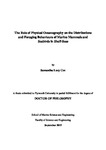The role of physical oceanography on the distributions and foraging behaviours of marine mammals and seabirds in shelf-seas
| dc.contributor.supervisor | Ingram, Simon N | |
| dc.contributor.author | Cox, Samantha Lucy | |
| dc.contributor.other | School of Biological and Marine Sciences | en_US |
| dc.date.accessioned | 2016-05-05T13:32:04Z | |
| dc.date.available | 2016-05-05T13:32:04Z | |
| dc.date.issued | 2016 | |
| dc.date.issued | 2016 | |
| dc.identifier | 10233591 | en_US |
| dc.identifier.uri | http://hdl.handle.net/10026.1/4579 | |
| dc.description.abstract |
Mid-latitude shelf-seas are highly productive regions that host a rich diversity of animals including large numbers of marine mammals and seabirds. These large vertebrate predators play a crucial role in the functioning of shelf-sea ecosystems. However, the combined effects of multiple anthropogenic stressors are driving unprecedented declines in many of their populations. Mitigating this depends upon effective conservation and integrated ecosystem based approaches to management, which require a comprehensive understanding of the habitat needs of marine predators. The foraging efficiencies of marine predators are closely tied to the availability of a number of oceanographic features. As such, these physical habitats represent critical locations within a species’ range whose preservation and protection should be of high priority. The collection of studies presented in this thesis aims to improve our understanding of the physical oceanographic processes that underlie the at-sea behaviours and distributions of marine mammals and seabirds in coastal and shelf-sea environments. A combination of at-sea boat surveying, animal-borne biologging, satellite remote-sensing, passive acoustics and numerical modelling was used to collect information on the distributions and foraging behaviours of a range of marine predators alongside the bio-physical characteristics of the oceanographic habitats they occupied. These data were then used to (1) examine the use of oceanographic habitats generated around tidal-mixing fronts and coastal topographic structures by a range of piscivorous species including bottlenose dolphins Tursiops truncatus, common dolphins Delphinus delphis, harbour porpoises Phocoena phocoena and northern gannets Morus bassanus, and (2) identify the physical processes underlying their creation. Original aspects of this work include the examination of the fine-scale bio-physical mechanisms that link marine predators to tidal-mixing fronts and coastal tidal-topographic structures. Main findings indicate that offshore habitats around tidal-mixing fronts are used by both common dolphins and northern gannets for foraging. Individuals associated with patches of increased sub-surface primary productivity, which were generated via a bi-weekly cycle of episodic turbulent mixing and stratification following an adjustment in the spatial position of a front with the spring-neap cycle. Moreover, around fronts, the dives of gannets were likely to be short and of a V-shaped strategy (with little active swim phase), which likely reflects an increase in the accessibility and catchability of their prey. In a coastal estuarine system, bottlenose dolphins were shown to associate with predictable downwelling features generated during flood tidal flows that were thought to act as a foraging aid. Together, these findings highlight the fundamental role physical oceanographic processes play in the structuring of marine ecosystems by providing vulnerable marine predators with prosperous and reliable foraging resources that they can exploit. This work has implications for both future studies of marine predator foraging ecology and the management of anthropogenic activities in coastal and shelf-seas. | en_US |
| dc.description.sponsorship | Natural Environment Research Council (NERC) | en_US |
| dc.language.iso | en | en_US |
| dc.publisher | Plymouth University | en_US |
| dc.subject | Spatial ecology | en_US |
| dc.subject | Oceanography | en_US |
| dc.subject | Marine top predators | en_US |
| dc.subject | Seabirds | en_US |
| dc.subject | Habitat use | en_US |
| dc.subject | Foraging ecology | en_US |
| dc.subject | Marine Mammals | en_US |
| dc.title | The role of physical oceanography on the distributions and foraging behaviours of marine mammals and seabirds in shelf-seas | en_US |
| dc.type | Thesis | |
| plymouth.version | Full version | en_US |
| dc.identifier.doi | http://dx.doi.org/10.24382/3273 |
Files in this item
This item appears in the following Collection(s)
-
01 Research Theses Main Collection
Research Theses Main


